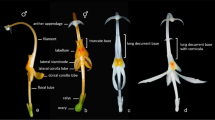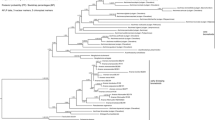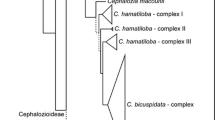Summary
Twenty-nine genera of the tribe Anthemideae (Compositae) (111 genera, ca. 1,800 species) are either restricted to or have their distributional centre in the S hemisphere. We here present a phylogenetic study based on nrDNA ITS and cpDNA ndhF sequence variation for a complete generic sampling of this S hemisphere group of the tribe with its paramount importance for the understanding of the evolutionary history of this plant group. Our results corroborate the paraphyletic nature of the S hemisphere group of Anthemideae as a whole and of the four subtribes (Ursiniinae, Gonosperminae, Thaminophyllinae, Matricariinae) erected by Bremer and Humphries (1993) to accommodate its members. We further show that the genus Osmitopsis and the Cotula- group hold a basal position in the tribe. Members of the subtribe Ursiniinae (that is characterised by the possession of anthers with polarised endothecial tissue) form a paraphyletic group that may, together with a strongly supported monophyletic group around the genus Pentzia, contain the sister group(s) of the Asian and Mediterranean clades of the tribe. As a consequence of the non-monophyletic nature of the subtribes according to Bremer and Humphries (1993), we discuss an alternative generic grouping of the S hemisphere Anthemideae.
Similar content being viewed by others
References
Anderberg AA and Swenson U (2003). Evolutionary lineages in Sapotaceae (Ericales): a cladistic analysis based on ndhF sequence data. Int J Pl Sci 164: 763–773
Anderberg AA, Eldenäs P, Bayer RJ and Englund M (2005). Evolutionary relationships in the Asteraceae tribe Inuleae (incl. Plucheeae) evidenced by DNA sequences of ndhF; with notes on the systematic position of some aberrant genera. Org Divers Evol 5: 135–146
Baagøe J (1977). Taxonomical application of ligule microcharacters in Compositae. I Anthemideae, Heliantheae, Tageteae. Bot Tidsskr 71: 393–223
Bayer RJ, Soltis DE and Soltis PS (1996). Phylogenetic inferences in Antennaria (Asteraceae: Gnaphalieae: Cassiniinae) based on sequences from nuclear ribosomal DNA internal transcribed spacers (ITS). Amer J Bot 83: 516–527
Bayer RJ, Breitwieser I, Ward JM and Puttock C (2006). Tribe Gnaphalieae (Cass.) Lecoq & Juillet. In: Kadereit, J and Jeffrey, C (eds) The families and genera of vascular plants, vol 8. pp 246–284. Springer, Berlin
Beauverd G (1915). Contribution á ĺetude des Composées. Bull Soc Bot Genève (ser 2) 7: 21–56
Bentham G (1873) Compositae. In: Bentham G, Hooke JD (eds) Genera plantarum, vol 2, no. 2. Reeve et Co., London, pp 163–533
Bohlmann F and Grenz M (1975). Neue Sesquiterpenlactone aus Athanasia-Arten. Chem Ber 108: 357–361
Bohlmann F and Rao N (1972). Neue Furansesquiterpene aus Athanasia-Arten. Tetrahedron Lett 1972: 1295–1296
Bohlmann F and Zdero C (1972a). Zwei neue Sesquiterpen-Lactone aus Lidbeckia pectinata Berg. und Pentzia elegans DC. Tetrahedron Lett 1972: 621–624
Bohlmann F and Zdero C (1972b). Ein neues Furansesquiterpen aus Phymaspermum parvifolium. Tetrahedron Lett 1972: 851–852
Bohlmann F and Zdero C (1974). Neue Acetylverbindungen aus südafrikanischen Vertretern der Tribus Anthemideae. Chem Ber 107: 1044–1048
Bohlmann F and Zdero C (1977). Ein neues Guajanolid aus Matricaria zuubergensis. Phytochemistry 16: 136–137
Bohlmann F and Zdero C (1978a). New Furansesquiterpenes from Eumorphia species. Phytochemistry 17: 1155–1159
Bohlmann F and Zdero C (1978b). New sesquiterpenes and acetylenes from Athanasia and Pentzia species. Phytochemisty 17: 1595–1599
Bohlmann F and Zdero C (1982). Sesquiterpene lactones from Inezia integrifolia. Phytochemistry 21: 2743–2745
Bohlmann F, Burkhart T and Zdero C (1973). Naturally occurring acetylenes. Academic, London
Boissier E (1849) Diagnoses plantarum orientalium novarum, vol 11. Ducloux, Paris, pp 95–96
Bremer K (1972). The genus Osmitopsis (Compositae). Bot Not 125: 9–48
Bremer K (1976). New taxa of Osmitopsis (Compositae). Bot Not 129: 21–24
Bremer K and Humphries CJ (1993). Generic monograph of the Asteraceae–Anthemideae. Bull Nat Hist Mus Lond Bot 23: 71–177
Bremer K and Källersjö M (1985). Taxonomic notes on Hymenolepis (Asteraceae–Anthemideae). Nord J Bot 5: 27–30
Brouillet L, Lowrey TK, Urbatsch LE, Wagstaff SJ, Karaman V (2006) The tribe Astereae, The International Compositae Alliance, Barcelona, p. 25
Bruhl JJ and Quinn CJ (1990). Cypsela anatomy in the ‘Cotuleae’ (Asteraceae–Anthemideae). Bot J Linn Soc 102: 37–59
Bruhl JJ and Quinn CJ (1991). Floral morphology and a reassessment of affinities in the ‘Cotuleae’ (Asteraceae). Austral J Bot 4: 637–654
Cassini H (1816) Anthémidées. In: Cuvier GLCFD (ed) Dictionaire des sciences naturelles, 2nd edn, 2 suppl. Strasbourg, Paris, pp 73–75
Cassini H (1817). Apercu des Genres nouveaux formés par M. Henri Cassini dans la famille des Synanthérés. Bull Sci Soc Philom Paris 1817: 151–154
Doyle JJ and Doyle JS (1987). A rapid DNA isolation procedure for small quantities of fresh leaf tissue. Phytochem Bull 19: 11–15
Eastwood A, Gibby M and Cronk QCB (2004). Evolution of St. Helena arborescent Astereae (Asteraceae) relationships of the genera Commidendrum and Melanodendron. Bot J Linn Soc 144: 69–83
Eldenäs P, Källersjö M and Anderberg AA (1999). Phylogenetic placement and circumscription of tribes Inuleae s. str. and Plucheeae (Asteraceae) Evidence from sequences of chloroplast gene ndhF. Molec Phylogenet Evol 13: 50–58
Farris JS, Källersjö M, Kluge AG and Bult C (1994). Testing significance of incongruence. Cladistics 10: 315–319
Felsenstein J (1981). Evolutionary trees from DNA sequences: a maximum likelihood approach. J Molec Evol 17: 368–376
Felsenstein J (1985). Confidence limits of phylogenies: an approach using the bootstrap. Evolution 39: 783–791
Francisco-Ortega J, Barber JC, Santos-Guerra A, Febles-Hernandez R and Jansen RK (2001). Origin and evolution of the endemic genera of Gonosperminae (Asteraceae: Anthemideae) from the Canary Islands: evidence from nucleotide sequences of the internal transcribed spacers of the nuclear ribosomal DNA. Amer J Bot 88: 161–169
Francisco-Ortega J, Santos-Guerra A, Hines A and Jansen RK (1997). Molecular evidence for a Mediterranean origin of the Macaronesian endemic genus Argyranthemum (Asteraceae). Amer J Bot 84: 1595–1613
Funk VA, Bayer RJ, Keeley S, Chan R, Watson L, Gemeinholzer B, Schilling E, Panero JL, Baldwin BG, Garcia-Jacas N, Susanna A and Jansen RK (2005). Everywhere but Antarctica: using a supertree to understand the diversity and distribution of the Compositae. Biol Skr 55: 343–374
Funk VA, Chan R and Keeley SC (2004). Insights into the evolution of the tribe Arctoteae (Compositae: subfamily Cichorioideae s.s.) using trnL-F, ndhF and ITS. Taxon 53: 637–655
Gadek PA, Bruhl JJ and Quinn CJ (1989). Exine structure in the ‘Cotuleae’ (Anthemideae, Asteraceae). Grana 28: 163–178
Gemeinholzer B, Oberprieler C and Bachmann K (2006). Using GenBank data for plant identification: possibilities and limitations using the ITS 1 of Asteraceae species belonging to the tribes Lactuceae and Anthemideae. Taxon 55: 173–187
Goertzen LR, Cannone JJ, Gutell RR and Jansen RK (2003). ITS secondary structure derived from comparative analysis: implications for sequence alignment and phylogeny of the Asteraceae. Molec Phylogenet Evol 29: 216–234
Guo Y-P, Ehrendorfer F and Samuel R (2004). Phylogeny and systematics of Achillea (Asteraceae–Anthemideae) inferred from nrITS and plastid trnL-F sequences. Taxon 53: 657–672
Hall TA (1999). BioEdit: a user-friendly biological sequence alignment editor and analysis program for Windows 95/98/NT. Nucleic Acids Symp Ser 41: 95–98
Heywood VH and Humphries CJ (1977). Anthemideae – systematic review. In: Heywood, VH, Harborne, JB and Turner, BL (eds) The biology and chemistry of the Compositae, vol 2, pp 851–898. Academic, London
Hoffmann O (1894) Compositae. In: Engler A, Prantl K (eds) Die natürlichen Pflanzenfamilien nebst ihren Gattungen und wichtigen Arten insbesondere den Nutzpflanzen 415. Wilhelm Engelmann, Leipzig, pp 87–391
Huelsenbeck JP, Ronquist F (2001) MrBayes: Bayesian inference of phylogenetic trees. Computer software. Available at http://brahms.biology.rochester.edu/software.html
Jobb G (2004) TREEFINDER version of November 2004. Computer software. Available at http://www.treefinder.de
Källersjö M (1985). Fruit structure and generic delimitation of Athanasia (Asteraceae–Anthemideae) and related South African genera. Nord J Bot 5: 11–26
Källersjö M (1988). A generic re-classification of Pentzia Thunb. (Compositae-Anthemideae) from southern Africa. Bot J Linn Soc 96: 299–322
Källersjö M (1991). The genus Athanasia (Compositae-Anthemideae). Opera Bot 106: 5–75
Kim K-J and Jansen RK (1995). ndhF sequence evolution and the major clades in the sunflower family. Proc Natl Acad Sci USA 92: 10379–10383
Kishino H and Hasegawa M (1989). Evaluation of the maximum likelihood estimate of the evolutionary tree topology from DNA sequence data and the branching order of Hominoideae. J Molec Evol 29: 170–179
Kornkven AB, Watson LE and Estes JR (1998). Phylogenetic analysis of Artemisia section Tridentatae (Asteraceae) based on sequences from the internal transcribed spacers (ITS) of nuclear ribosomal DNA. Amer J Bot 85: 1787–1795
Kress WJ, Wurdack KJ, Zimmer EA, Weigt LA and Janzen DH (2005). Use of DNA barcodes to identify flowering plants. Proc Natl Acad Sci USA 102: 8369–8374
Lewis PO (2001). Phylogenetic systematics turns over a new leaf. Trends Ecol Evol 16: 30–37
Liu JQ, Gao TG, Chen ZD and Lu AM (2002). Molecular phylogeny and biogeography of the Qinghai-Tibet Plateau endemic Nannoglottis (Asteraceae). Molec Phylogenet Evol 23: 307–325
Markos S and Baldwin BG (2001). Higher-level relationships and major lineages of Lessingia (Compositae, Astereae) based on nuclear rDNA internal and external transcribed spacer (ITS and ETS) sequences. Syst Bot 26: 168–183
Morgan DR (1997). Reticulate evolution in Machaeranthera (Asteraceae). Syst Bot 22: 599–615
Nesom G and Robinson H (2006). Tribe Astereae Cass. In: Kadereit, J and Jeffrey, C (eds) The families and genera of vascular plants, vol 8. pp 284–342. Springer, Berlin
Nordenstam B (1976). Re-classification of Chrysanthemum L. in South Africa. Bot Not 129: 137–164
Nordenstam B (1987). Notes on South African Anthemideae (Compositae). Opera Bot 92: 147–151
Noyes RD (2000). Biogeographical and evolutionary insights on Erigeron and allies (Asteraceae) from ITS sequence data. Pl Syst Evol 220: 93–114
Noyes RD and Rieseberg LH (1999). ITS sequence data support a single origin for North American Astereae (Asteraceae) and reflect deep geographic divisions in Aster s.l. Amer J Bot 86: 398–412
Oberprieler C (2001a). Phylogenetic relationships in Anthemis L. (Compositae, Anthemideae) based on nrDNA ITS sequence variation. Taxon 50: 745–762
Oberprieler C (2004a). On the taxonomic status and the phylogenetic relationships of some unspecific Mediterranean genera of Compositae-Anthemideae I. Brocchia, Endopappus and Heliocauta. Willdenowia 34: 39–57
Oberprieler C (2004b). On the taxonomic status and the phylogenetic relationships of some unspecific Mediterranean genera of Compositae-Anthemideae II. Deveaua, Leucocyclus and Nananthea. Willdenowia 34: 341–350
Oberprieler C (2005). Temporal and spatial diversification of Circum-Mediterranean Compositae-Anthemideae. Taxon 54: 951–966
Oberprieler C and Vogt R (2000). The position of Castrilanthemum Vogt & Oberprieler and the phylogeny of Mediterranean Anthemideae (Compositae) as inferred from nrDNA ITS and cpDNA trnL/trnF IGS sequence variation. Pl Syst Evol 225: 145–170
Oberprieler C and Vogt R (2002). A phylogenetic analysis of Chamaemelum Mill. (Compositae Anthemideae) and related genera based upon nrDNA ITS and cpDNA trnL/trnF IGS sequence variation. Bot J Linn Soc 138: 255–273
Oberprieler C, Vogt R and Watson LE (2006). Tribe Anthemideae Cass. (1819). In: Kadereit, JW and Jeffrey, C (eds) The families and genera of vascular plants, vol 8. pp 342–374. Springer, Berlin
Panero JL and Funk VA (2002). Toward a phylogenetic subfamilial classification for the Compositae (Asteraceae). Proc Biol Soc Wash 115: 909–922
Posada D and Crandall KA (1998). Modeltest: testing the model of DNA substitution. Bioinform Appl Notes 14: 817–818
Reitbrecht F (1974) Fruchtanatomie und Systematik der Anthemideae (Asteraceae). Unpublished Thesis, Wien
Robinson H and Brettell RD (1973). Tribal revisions in the Asteraceae VIII. A new tribe, Ursinieae. Phytologia 26: 76–85
Rydin C, Pedersen KR and Friis EM (2004). On the evolutionary history of Ephedra: cretaceous fossils and extant molecules. Proc Natl Acad Sci USA 101: 16571–16576
Stix E (1960). Pollenmorphologische Untersuchungen an Compositen. Grana Palynol 2: 39–114
Swofford DL (2002). PAUP*: phylogenetic analysis using parsimony (*and other methods) 4.0b10. Sinauer, Sunderland
Unwin M, Bayer RJ, Ward JM, Breitwieser I, Koekemoer M, Galbany M (2006) Phylogenetic relationships in the Gnaphalieae (Asteraceae). The International Compositae Alliance, Barcelona, p. 24
Vallès J, Torrell M, Garnatje T, Garcia-Jacas N, Vilatersana R and Susanna A (2003). The genus Artemisia and its allies: Phylogeny of the subtribe Artemisiinae (Asteraceae, Anthemideae) based on nucleotide sequences of nuclear ribosomal DNA internal transcribed spacers (ITS). Pl Biol 5: 274–284
Wagstaff SJ and Breitwieser I (2002). Phylogenetic relationships of New Zealand Asteraceae inferred from ITS sequences. Pl Syst Evol 231: 203–224
Watson L, Bates P, Evans T, Unwin M and Estes J (2002). Molecular phylogeny of subtribe Artemisiinae (Asteraceae), including Artemisia and its allied and segregate genera. BMC Evol Biol 2: 17
Watson LE, Evans TM and Boluarte T (2000). Molecular phylogeny and biogeography of tribe Anthemideae (Asteraceae), based on chloroplast gene ndhF. Molec Phylogenet Evol 15: 59–69
White TJ, Bruns T, Lee S and Taylor J (1990). Amplification and direct sequencing of fungal ribosomal RNA genes for phylogenetics. In: Innis, M, Gelfand, D, Sninsky, J, and White, T (eds) PCR Protocols: a guide to methods and applications, pp 315–322. Academic, San Diego
Author information
Authors and Affiliations
Corresponding author
Rights and permissions
About this article
Cite this article
Himmelreich, S., Källersjö, M., Eldenäs, P. et al. Phylogeny of southern hemisphere Compositae-Anthemideae based on nrDNA ITS and cpDNA ndhF sequence information. Plant Syst Evol 272, 131–153 (2008). https://doi.org/10.1007/s00606-007-0634-y
Received:
Accepted:
Published:
Issue Date:
DOI: https://doi.org/10.1007/s00606-007-0634-y




